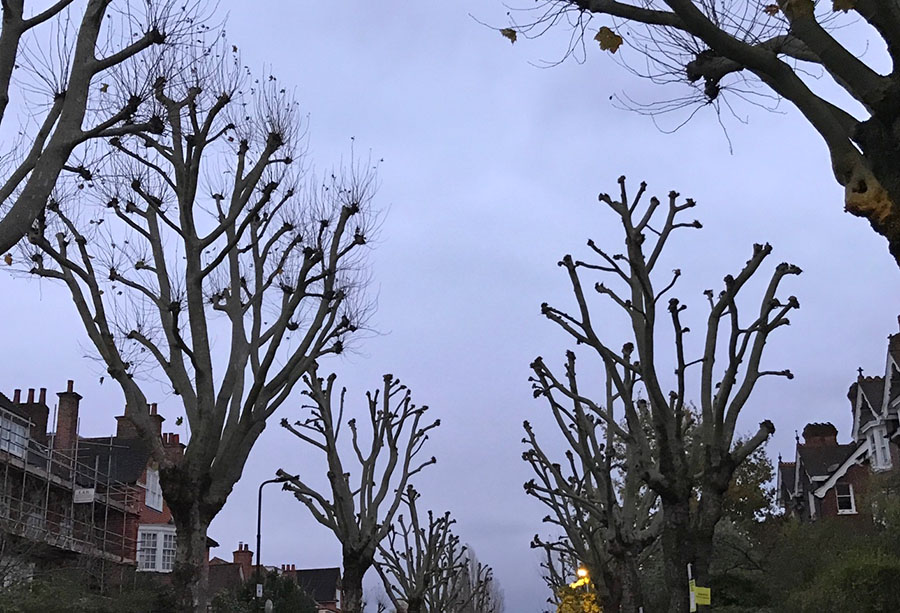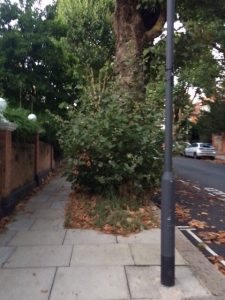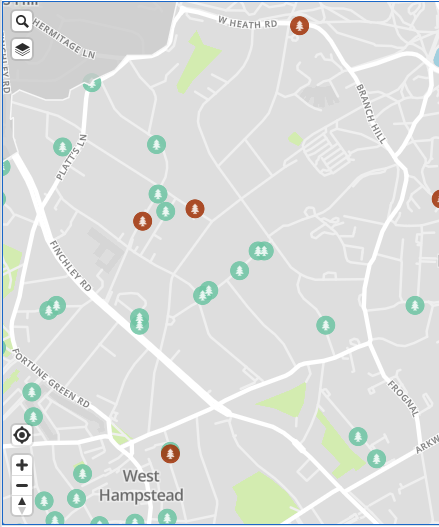The vital role of Camden’s street trees
A healthy urban tree canopy is important for improving air quality by removing pollutants as well as for storing carbon captured from the air.
The amenity value of council-managed trees as calculated by Capital Asset Valuation of Amenity Trees (CAVAT) in is calculated to be £343.2 million (2019). Their value for some individual benefits is set out below.
Value of Benefits from Camden’s Street Trees, 2017
|
Benefit |
Amount |
Value (£ thousands |
|
Pollution removal |
5 tonnes p.a. |
£175.5 p.a. |
|
Carbon storage |
10,800 tonnes |
£691.3 |
|
Carbon sequestration |
107 tonnes p.a. |
£48.5 p.a. |
|
Avoided surface water runoff |
6,739 cu. metres p.a. |
£10.2 p.a. |
Source: iTree Eco inventory study
The Council is committed to increasing Camden’s leaf canopy cover. Camden’s pollarding policy is not consistent with this aim and is jeopardising the health of RedFrog street trees.
All street trees, from ornamentals to very mature and veteran plane trees, are pollarded biennially. The frequency and severity of pollarding, whereby trees have no canopy in the year of pollarding and minimal canopy the following year, is such that their amenity value is greatly reduced.
Pollarding additionally causes harm both to the trees and to the leafy character of the Conservation Area, as noted in the Redington Frognal Conservation Area Appraisal and Management Plan.
It is likely that the pollarding is also compromising health of the veteran plane trees, which are displaying signs of stress, eg excessive epicormic growth and basal fungal growths (leading to a number of fellings).
Camden’s pollarding policy is jeopardising the health of street trees
Camden operates a biennial pollarding policy, which is jeopardising the health of RedFrog street trees and stripping them of their leaf canopies.
A recent report ‘Trees on the Edge’ came to quite damning conclusions, establishing beyond doubt that the current policy is perverse, destructive, expensive and is not working. The report concludes that the policy of bi-annual reduction be stopped immediately, and proposes urgent amendments to the current Tree Policy in order to “reverse this pointless destruction, promote a green and healthy environment and reassure residents whose confidence in the councils’ competence has been severely eroded”.
You can read the executive summary below, or read the full report Trees on the Edge here:
The Demise of Camden’s Street Trees – 311018
Pollarded trees on right (with trees awaiting pollarding on left), November 2020
Below, a distressed plane tree producing epicormic growth, Summer 2018
Trees on the Edge – A report and proposals
Executive Summary
This report is based on answers to Freedom of Information requests, information from Camden Open Data, an internal presentation made by Camden Tree Officers in 2015, contributions from local groups and committees and the study of recent academic and professional materials.
Camden Trees Department characterises large parts of the borough as having a significant subsidence problem. Their policy of bi-annual pollarding is based on the belief that this will protect the council (a) by having a maintenance programme that is defendable when subsidence claims arise and (b) leading to a reduced risk of them arising in the first place.
The consequences of this policy are degrading the urban environment in these wards and post codes to an unacceptable level. The leaf canopy is disappearing as streets are denuded of full sized trees while virtually all benefits provided by mature trees, be it air quality, shade, habitat and more are fast disappearing. The Council is knowingly destroying mature trees, indeed their website states this is ‘unfortunate but unavoidable’. 1
Through Freedom of Information requests to the councils of Camden, Hackney, Westminster and Islington this new report establishes beyond doubt that the current policy is perverse, destructive, expensive and is not working. The report finds that of the four councils Camden has:
- The largest tree maintenance and planting budget.
- The second fewest street trees.
- The largest number of trees felled per annum
- The most trees planted per annum
- The most statistical data and records
- The laxest replanting & monitoring programme
- The weakest benchmarking for tree maintenance standards, and
- The same low rate of tree related subsidence as its neighbours who do not routinely pollard their mature trees. 2.
The report concludes that the policy of bi-annual reduction also known as stripping and topping be stopped immediately. Furthermore, it proposes urgent amendments to the current Tree Policy in order to reverse this pointless destruction, promote a green and healthy environment and reassure residents whose confidence in the councils’ competence has been severely eroded.
A full report of Trees on the Edge is available here:
The Demise of Camden’s Street Trees – 311018.pdf
The report was written by Harvey Flinder, a resident of Camden for over 30 years, it is supported by and represents the views of local residents groups, local Conservation Area Committees, Air Quality Action Groups, Councillors, and activists in local politics and environmental issues.
Pollarding of street trees and feelings in RedFrog
Ref: MEM16699
This is the response to (your) enquiry MEM16699, raised on behalf of the Chairman of Redington Frognal Association. Your data request and the answers to the questions raised are set out below:
- Data on the tree removal in the Frognal ward for the last 20 years and pruning for the last 5 years.
Attached you will find a table providing the data for tree removal for the last 20 years and tree pruning for the last 5 years in the Frognal Ward. Please note that this has been reported by financial year, which is how the data is recorded in our asset maintenance database confirm arboriculture. The way we use the database and the type of data recorded has changed over the last 20 years, so earlier records may not have data recorded. For example, some of our earlier information on the reason for a tree being felled has not been recorded consistently.
From the data provided. You will see that out of the 118 trees removed in the ward over the last 20 years, only 13 have been part of our biennial reduction programme.
- Lack of oversight of contractor
The contractor is monitored as per our tree work specification, which requires them to monitor 20% of the work they complete. The sample of work monitored is generated randomly by the tree team and issued to the contractor to complete before payment. To check this has been done, tree officers also monitor a minimum of 10% of monitoring the contractor does. Any work found not to meet the contract specification results in a rectification notices being issued and potential a fine per job. Failure to comply with the rectification notice can result in a default notice and fine being applied.
As well as monitoring work, the contractors crews are periodically checked (1 per month) to make sure they are adhering to all health and safety regulations. Any issues found are addressed immediately or work is stopped until it is safe to continue.
- Trees along Ferncroft Avenue have been cut below previous pollard points.
I have had a tree officer check the work along Ferncroft Avenue and they have confirmed the work has been carried out as specified. They did not see any evidence of trees being cut below their pollard points.
- What grounds is it considered that all of the trees along Kidderpore Gardens are likely to cause subsidence?
Information on subsidence and why trees are included in our biennial reduction regime was presented to the Culture and Environment Scrutiny committee on Wednesday 6th November 2019, in a paper that sets out the councils tree management policy.
I have checked our records for Kidderpore Gardens and none of the trees are part of the biennial reduction programme. Work to re-reduced those trees has been prescribed following an inspection as part of our 3 year cyclical maintenance programme to address a defect. In this case, the trees have been previously re-reduced and the re-growth from the last reduction will be weakly attached. If left to grow, it will become susceptible to snapping during adverse weather and risks injuring users of the highway. This is an unacceptable risk for the public, which is why the work has been ordered.
Information on why work is being carried out to trees can be found on the council’s tree pages: www.camden.gov.uk/trees
- How long will it be before other pollarded veterans develop fungal growths?
The Woodland Trust defines a veteran tree as a tree that has some of the features of an ancient tree, not necessarily as a consequence of time, but of its life or environment. This usually presents itself as wounds, decay and deadwood that provides habitats for organisms. We currently have 41 veteran trees we look after in the borough and none of these are on the highway.
Decay occurs through the action of fungal pathogens that have infected a tree through a wound, which can be created through pruning, natural branch shedding branch breakage, pest or mechanical damage. Any signs of decay are normally found close to the point of entry, but can spread from that point affecting others parts of the tree.
Although the data we have on the reasons trees have been felled is incomplete due to a change in working practices. It does show that 6 trees out of the 13 felled which were part of our biennial reduction programme, had the reason for removal recorded as basal decay. This is more likely to have been caused through root damage through the installation of underground utilities, vehicle strikes or other highway works, rather than our biennial reduction programme. Our tree work is carried out according to best practice, keeping pruning wounds as small as possible, and is unlikely to be the cause of any decay.
Regards
David Houghton
Tree Manager
Council Trees in Camden Map:
Redington Frognal: vacant tree pits (green circles) and street trees scheduled for felling (red circles)
More information can be found on Camden’s Open Data portal:
https://opendata.camden.gov.uk/Environment/Trees-In-Camden/csqp-kdss/data
Fallen street trees
Trees on council land are managed by Camden’s Arboricultural service, which also operates an emergency call out system for trees that have fallen within Council land, or have fallen onto the highway.
Commemorative Planting
It is possible to request to plant commemorative trees on Council-owned land including. The cost is
- £574.00 for the tree, planting and three years watering and maintenance + VAT
- £608.98 for an administration fee
Email: treesection@camden.gov.uk
Website: www.camden.gov.uk/trees
Tree Planting
Tree planting is important for health, wellbeing, cooling, shading, air quality, reducing the risk of flooding by reducing surface water runoff, and to support wildlife. Trees selected for planting should have a high value to insects, as in the list below, where trees are arranged in order of the number of species supported.
Trees to enhance biodiversity and conservation area character, as found in the London Survey
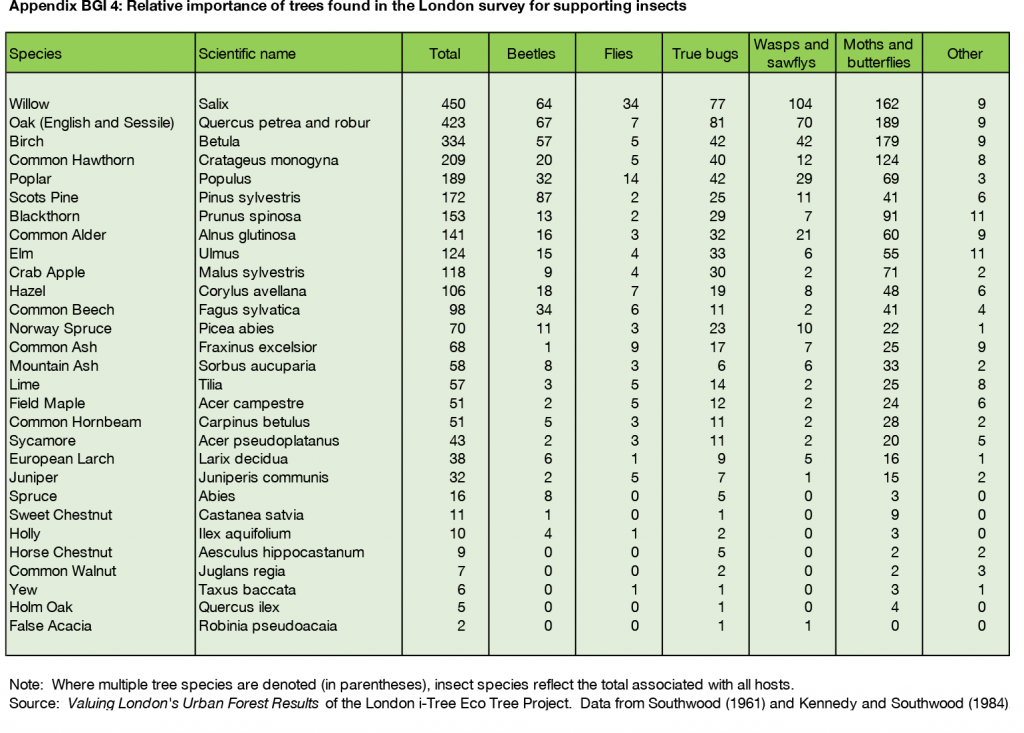
Tree planting in hard surfaces
Tree planting in hard surfaces can be facilitated by incorporating a root barrier to line a tree pit.
Root Barriers for Hard Surface Planting

The perimeter of a tree pit can be lined with a durable impermeable membrane. This will force the roots vertically to depths of about 150 cm before they spread laterally. A root barrier is an effective means of reducing the risk of shrinkage / heave of ground beyond the tree pit.
Advantages are:
- protection of the area surrounding the tree;
- enabling the tree to receive optimum oxygen and water levels;
- ensuring against damage to structures;
- enabling trees to flourish and grow to maturity;
- offering protection to utilities, service ducts and paved areas.
Root barriers are inexpensive, with a cost of c. £30 per square metre.
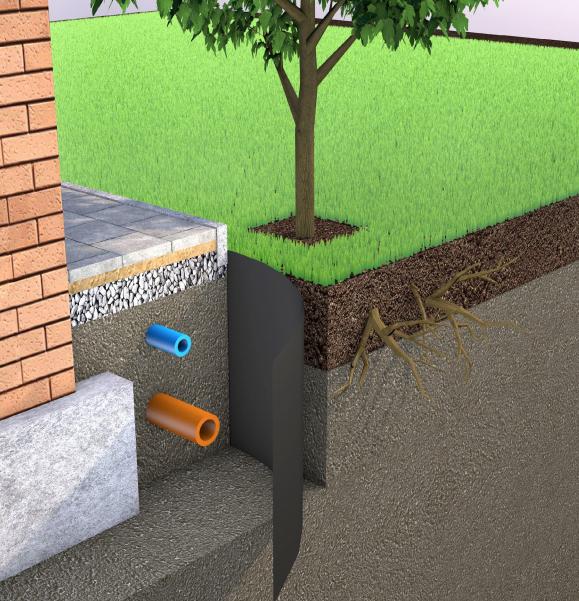
Suppliers include AHS Ltd:

